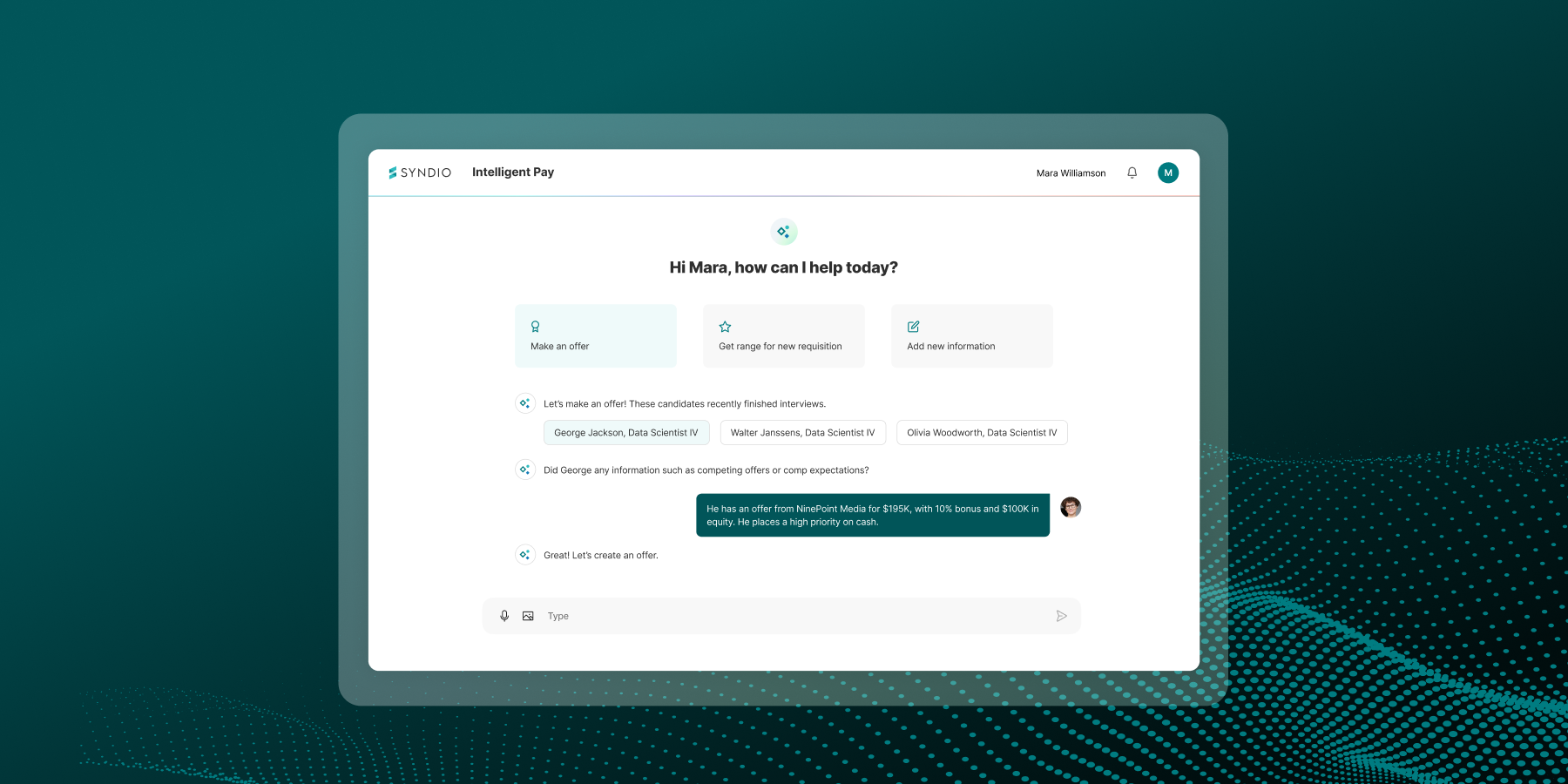When it comes to pay equity analyses, many companies fear that they’re “just not ready” to dive into the data. But the reality is that, whether you’ve identified them or not, pay gaps exist. And in today’s era of pay transparency, they matter more than ever — to investors and boards, employees and job seekers, consumers, regulators, and legislators.
With all these pressures making a clear case for companies to get ahead of pay equity, what’s holding so many back from tackling it? Syndio has helped hundreds of companies all over the world conduct, communicate, and sustain pay equity. Below are the most common pay equity myths we’ve heard working with our customers. Do any of these sound familiar? The reality may surprise you!
Myth #1: “We need clean data.”
The reality: 100% of companies have missing or messy data — our technology and team of experts can help you impute your data and work around gaps.
No company has perfect data — but if you’re paying people, then you have the data you need to get started. Syndio’s team of data scientists and labor economists can help you look at your data to see what you have to work with and where there are gaps. They are accustomed to working with incomplete data and can make reasonable assumptions, such as identifying proxies for experience, in order to work around gaps to build a more accurate analysis in the platform.
The best part? This exercise becomes an opportunity to clean up your data and create a plan for what your company needs to collect to conduct more robust analyses going forward. This can become a touchpoint with leadership about the necessity of putting muscle behind the effort of employee data integrity. Additionally, when you identify additional data points to start collecting, you create an avenue to communicate with employees about your pay equity commitment, efforts, and progress.
Myth #2: “We need a compensation philosophy before we can start.”
The reality: Many companies don’t have a formal philosophy — we help you test your pay practices so you can better understand and articulate your compensation philosophy.
Syndio’s experts can help you unpack what you actually rely on to dictate pay, then use our platform to stress test your pay policies and practices . This will allow you to better understand — then articulate — the philosophy underpinning the mechanics of your compensation program.
Even if you do have a formal compensation philosophy, this exercise can be eye opening. Some companies we work with have realized that what they say they pay for (e.g. “We pay for performance”) was not actually what they were paying for in some or all areas of their organization. Syndio will test your philosophy against the outcomes of your analysis to show how your company is determining and delivering pay in practice.
In fact, our customers are able to dig deeper into their use of metrics tied to compensation like performance ratings. For example, with software, it’s easy to test impacts with and without performance ratings as a control. Customers then use insights from the analysis to make improvements to their programs.
Myth #3: “We need a better compensation structure/ levels/ pay bands so we can accurately compare jobs.”
The reality: Syndio’s experts work with what you have to help you create accurate comparisons and improve pay structures.
Conventional thinking dictates that you need a well-defined job architecture before you can even begin thinking about a pay equity analysis. After all, how can you compare jobs without the foundation of a structure that establishes how jobs are valued internally?
The truth is, you are delivering compensation through some set of values and criteria, which means you have at least enough information to perform a baseline analysis. Syndio’s team of experts can use the clues in the data you have — such as job titles, reporting relationships, levels of pay, departments, or countries/locations — to help you create the right job groupings to perform an analysis. In our experience, most companies that don’t have “fully-baked” compensation structures are surprised to find they’re able to make accurate comparisons across most of their population.
Further, because Syndio’s platform provides insights into how your company is delivering pay, our collaboration provides the opportunity to build or refine the design of your compensation structure.
Myth #4: “We need months of runway for analysis.”
The reality: Pay equity software is fast — once data is uploaded and configured, instant analysis provides immediate insights.
If you’ve got what feels like a thousand competing priorities and your team is stretched thin, you might feel that you just don’t have time for a pay equity analysis on top of everything else. After all, traditional manual pay equity analyses calculated inside spreadsheets take an average of two to five months to complete.
However, if you use pay equity software, you don’t need months! The advanced math and methodology needed to run a pay equity analysis are embedded into Syndio’s PayEQ® software — so once the right data, groupings, and controls are set up in the system, analysis is instantaneous. Syndio’s team even does some of the heavy lifting of configuring your baseline analysis so that you can get up and running quickly and efficiently.
Additionally, by using sophisticated software with data visualization capabilities, it’s easier to identify where you might need to reconfigure and regroup data. Since you’re able to work with data in a more nimble way than is possible in spreadsheets, this makes the iterative part of the process faster too! You can find and address outliers and complexities in your data, test hypotheses, move things around, and see the impact of changes in real time.
Myth #5: “One large analysis per year is optimal.”
The reality: Because compensation changes happen all of the time, data quickly becomes outdated and you can’t make data-driven decisions that will prevent issues. Frequent analyses make disparities easier to prevent.
When pay equity analyses feel like a huge, burdensome lift, it makes sense that companies only want to do it once a year. But an annual approach isn’t optimal because compensation changes throughout the year mean that your company will immediately fall behind again on pay equity. An annual analysis creates a cycle of constantly playing “catch up,” rather than getting out in front of the impact of changes.
Our intuitive platform and expert guidance will lighten the load so you can be up and running quickly — and running analyses more often. By analyzing and monitoring pay equity more frequently, you’ll be in a position to prevent pay inequities and avoid extensive (and expensive) structural changes and remediations during your annual increase cycle.
A comprehensive Workplace Equity Platform also provides insight into other root causes of inequities, such as pay policies, hiring trends, and starting pay. The goal is to reach a place of ongoing workplace equity management, rather than performing an annual, backward-looking audit.
Myth #6: “We don’t have the resources required, such as internal statisticians.”
The reality: Technology paired with expert guidance enables companies to perform pay analyses without a lot of resources.
Many companies overestimate how many resources they need to perform a pay equity analysis, which holds them back from making it a priority. However, purpose-built pay equity technology empowers companies to be more efficient with fewer resources.
Instead of budgeting headcount for internal statisticians, you can invest in software that provides best-in-class statistical expertise, as well as ongoing access to Syndio’s team of experts. We’ll help you configure your data, interpret your results, and determine next steps. The self-serve insights from our platform combined with support from our team empowers companies to take the reins of exploring their pay data and controlling their analyses.
Myth #7: “We shouldn’t dig into the data because we might unearth something that will hurt the company.”
The reality: Pay gaps exist whether you’ve identified them or not. The cost of not doing anything is greater than the cost of taking action.
In the U.S., the legal fear that “what is discovered, must be acted upon,” holds a lot of companies back from performing pay equity analyses — even though it’s the right thing to do and good for business. But hiding your head in the sand and ignoring pay equity doesn’t make inequities go away. And the truth is: every company has pay gaps, whether you have “found” them or not.
The era of pay transparency is here and it’s global. In the U.S., pay scale transparency legislation continues to expand. We are seeing similar calls for transparency in Europe. In March 2021 the EU proposed a directive aimed at ensuring that the right to equal pay is upheld across all member states. There are also pay reporting laws across Europe, including new laws in Ireland. Germany, France, Iceland, the United Kingdom, Switzerland, and several others have already enacted regulations around equal pay for equal work and the gender pay gap.
And then there are shareholder and ESG pressures. The SEC is considering recommendations on board diversity and human capital management disclosures in the U.S. The European Financial Reporting Advisory Group (EFRAG) recently laid out proposed reporting requirements for EU companies regarding ESG risks and opportunities.
On top of that, employees are taking matters into their own hands and sharing salaries among themselves. When it comes to your company’s pay practices, there’s no longer anywhere to hide.
Thus, avoiding pay equity issues now will only lead to bigger problems later on, which can come in the form of employee complaints, discrimination law suits, damaged brand reputation, difficulties hiring and retaining top talent, and increased scrutiny from boards and investors.
Additionally, the longer you put off addressing inequities, the more expensive remediation becomes. The average increase in remediation for every year a business waits, or fails, to address inequity is $439,000. While remediation has the potential to be costly, it’s a small price to pay to control the narrative before someone else tells your pay story for you.
Pay equity is a journey and data helps drive better decision-making on the road to progress. The sooner you look under the hood at your data, the farther along you’ll be towards creating a roadmap with realistic, credible goals. You won’t fix issues overnight, but you’ll be able to show progress to all the stakeholders demanding proof.
Myth #8: “It’s too hard to analyze across different currencies, pay practices, and reporting requirements for a global organization.”
The reality: Syndio’s software and expertise can help ensure your approach is globally consistent, while remaining responsive to local market practices.
Many global companies are held back by wondering, “How do we even begin?” With multiple currencies, pay policies, and legislation to account for, global analysis can seem daunting.
Syndio’s PayEQ® software provides built-in functionality to help companies account for all of these complexities so that you can run a robust statistical analysis across your global employee population. And Syndio has experts across different markets who can help you figure out the best place to start.
Also, it’s okay to start with a smaller focus and then scale. Companies who are not yet ready to do a global analysis for other reasons can begin by prioritizing the countries where they have the most employees or more active pay equity legislation. After developing and refining their pay equity analysis processes with those countries, they can then roll out a global program by onboarding other countries over time.

Consider these pay equity myths busted. Now what?
Now is the time to look past these pay equity myths and face reality, but you don’t have to do it alone.
Pay equity is a journey of progress, not instant perfection — and one thing we know for sure is that “one size doesn’t fit all.” Wherever your company is in your pay equity journey, Syndio will meet you where you are to determine the best approach.
Our Workplace Equity Platform provides the nimble, efficient engine that powers pay equity analyses, backed by our expert advisors who make sure it’s done right. We’ll help you figure out where and how to start to head towards lasting change — the important thing is to start!



